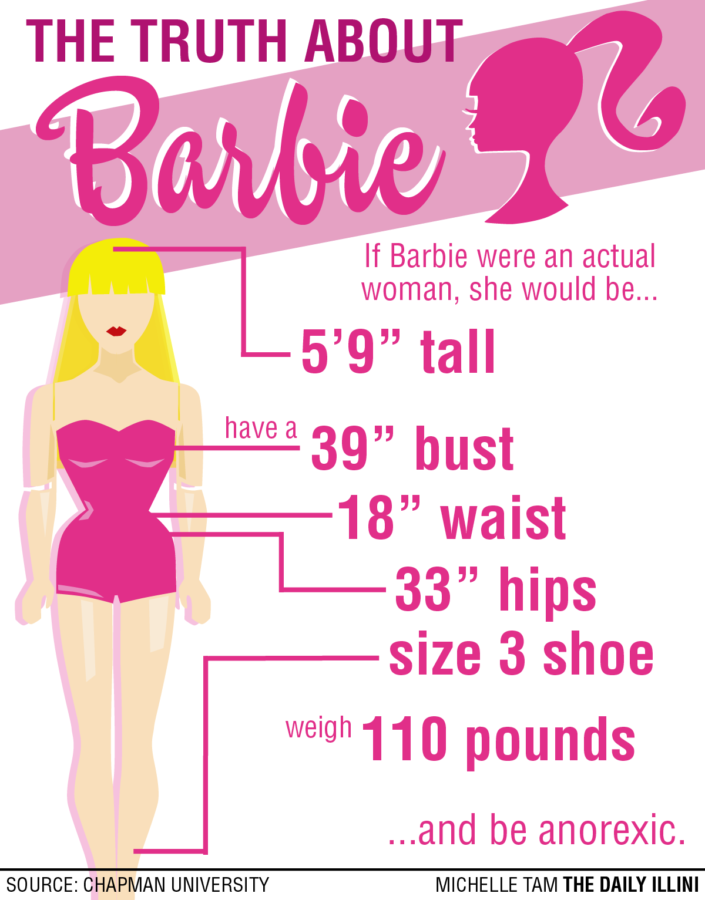Mattel's progress smaller than Barbie's waist
Feb 1, 2016
Last updated on Jan. 7, 2017 at 09:39 p.m.

Barbie—the eleven-and-a-half inch tall trophy of American beauty standards, represented from the top of her golden helmet of hair, to her toes fixed permanently into an arch for the perfect high heeled shoe. Barbie biographer M.G Lord sums it up in Time magazine: Barbie was designed to “teach women what—for better or worse—is expected from them in society.”
SO
These kind of expectations are placed on young girls who are just being exposed to womanhood from an early age. Developmental Psychology published a study in 2006 that revealed how girls exposed to Barbie at a young age caused greater concern of being “thin”, when compared to other girls that played with different dolls.
SO
In response to the years of demand for a more realistic portrayal of a woman’s body in their dolls, Mattel finally released a new line of Barbies with three new body types— “petite”, “curvy” and “tall”. The “Fashionistas” line also includes a variety of skin tones, eye colors and hairstyles to represent different variations of the American woman.
SO
Get The Daily Illini in your inbox!
Many feminists celebrated this victory in body image, causing Time magazine to publish a cover featuring a Barbie doll and the caption, “Now can we please stop talking about my body?”
SO
Although Mattel’s attempt to expand inclusiveness in different body shapes was made with good intentions, it ultimately places femininity back into the same position—placing the primary importance of a woman on her outward appearance. The Time magazine’s title is ironic in that Mattel has facilitated more attention and debate on Barbie’s body shape, rather than less.
Instead of distributing the different body shape prototypes throughout all Barbies, the new body shapes were featured only in one line. Other upcoming lines and previously released lines are to remain the slim-limbed, big-breasted and thin-waisted figure for which Barbie was originally known.

While the slim, traditional Barbie figure is seen frequently dressed in different types of occupational wear, the Barbies of other body shapes are present only in the “Fashionistas” line. This isolation will implement an intrinsic mindset into the minds of the children playing with them—that only slim-built figures find success in the adult world.
The effect of this is that the new Barbie line with varying body shapes is presented as an anomaly, something out of the ordinary. But the truth is, the average American woman does not look like the figure of the traditional Barbie.
Due to this segregation, young girls fail to recognize the realistic representation of the new Barbies’ body figures, continuing to identify the supermodel-esque physique of the traditional Barbie as the ideal. In an experience published in Time, when young girls were presented with the “curvy” doll, they hesitatingly admitted that she was “a little chubbier”, and even snicker when undressing her.
SO
Another consequence of the “Fashionistas” line is that the woman becomes solely identified by her body shape or other aesthetic features rather than any other distinguishing traits such as a career or personality. Unlike the “Major League Baseball Player Barbie”, “Presidential Candidate Barbie” or the “Computer Engineer Barbie”, the “Fashionistas” line doesn’t seem to have a feminist-empowering purpose but only seems to enjoy fashion and be distinguished by her outward appearance.
A final important impact of the segregated line of Barbies is that since “curvy Barbie” or “tall Barbie” isn’t present in any other Barbie line, it gives the impression to young girls that it’s not possible to succeed without being supermodel slim.

Although Mattel has initiated the steps to develop a more intrinsic and accepting image for their dolls, there are yet more improvements that can be implemented, such as to introduce the new body shapes generally across all Barbies instead of isolating them into one line.
It is important to ensure that a healthy and empowering message is being sent out to the younger generation interacting with Barbie dolls.
Minju is a freshman in LAS.
[email protected]






